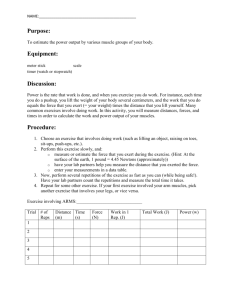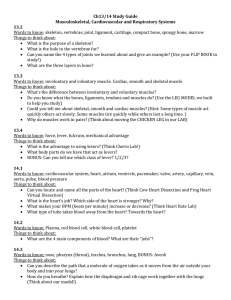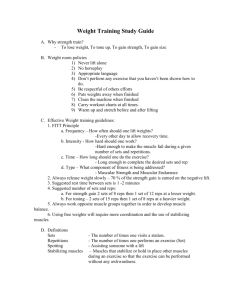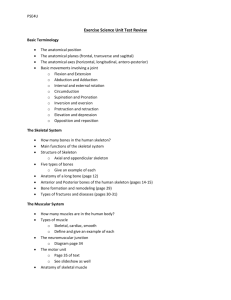Introduction to the Weight Room
advertisement
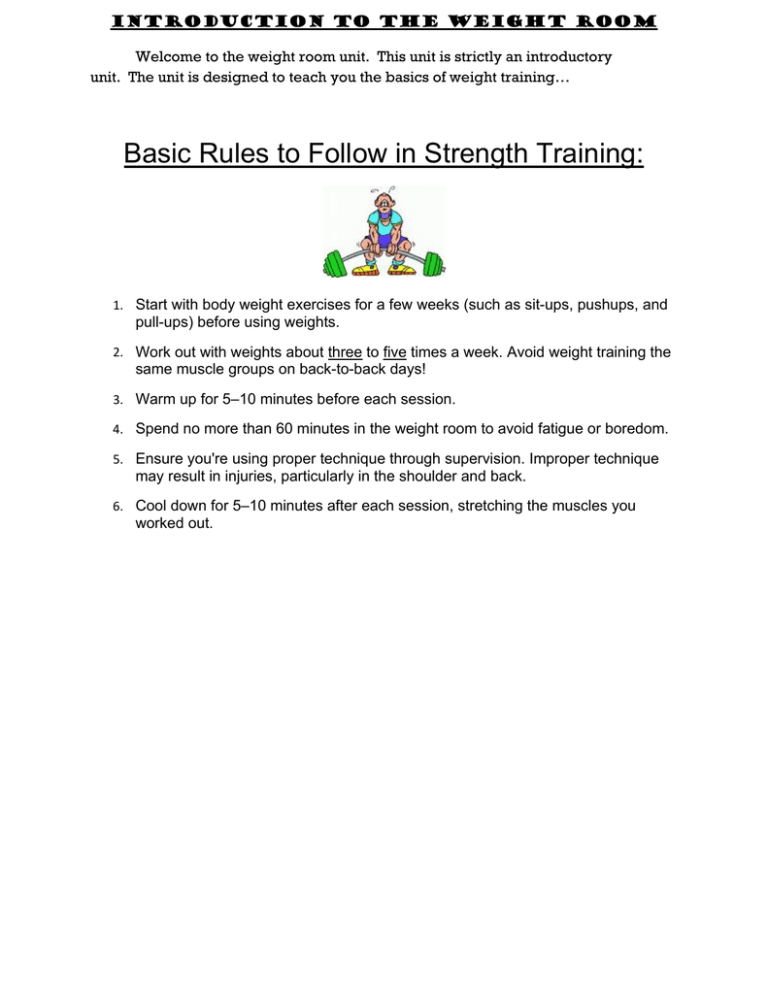
Introduction to the Weight Room Welcome to the weight room unit. This unit is strictly an introductory unit. The unit is designed to teach you the basics of weight training… Basic Rules to Follow in Strength Training: 1. Start with body weight exercises for a few weeks (such as sit-ups, pushups, and pull-ups) before using weights. 2. Work out with weights about three to five times a week. Avoid weight training the same muscle groups on back-to-back days! 3. Warm up for 5–10 minutes before each session. 4. Spend no more than 60 minutes in the weight room to avoid fatigue or boredom. 5. Ensure you're using proper technique through supervision. Improper technique may result in injuries, particularly in the shoulder and back. 6. Cool down for 5–10 minutes after each session, stretching the muscles you worked out. Weight Training: For the purpose of our weight-training unit, our type of weight training is geared towards educating you in the weight room and in general fitness. You WILL NOT be lifting for POWER! You will learn to lift in a slow and controlled manner, always being in control of the weight and never letting the weight control you. Our class will utilize the 2/4 lifting style, this means you will have a 2 second count whenever you start to move the weight until you reach the apex, and you will have a 4 count when returning the weight back to its starting position. Please remember that accidents can be controlled and/or eliminated if you lift under control, pay attention to the surrounding environment and remember that this is an introductory unit, lifting heavy or to impress your friends is not important, learning to lift properly and safely. Benefits of Weight Training: Helps control blood pressure Increases muscle strength Reduces body fat Improves posture Help prevent injury from normal activities Increases muscular endurance Improves physical appearance Raises your metabolic rate Can lower your resting heart rate Different Ways to Weight Train: Everyone who weight trains has their own personal goals that guide their training program. However most people who choose to weight lift, do so in order to gain or get bigger muscles, or to tone their muscles. Weight Training to Gain muscle: (Making your muscles bigger, by training them to lift large amount of weights for shorter periods of time) Heavy weights Low number of repetitions (6-8) Low number of sets (1-2) Weight training to Tone muscle: (Lifting weights in order to define and firm current muscles without getting bigger muscles) Less weight High number of repetitions (12-15) High number of sets (2-3) Workout Log, Sets and Repetitions When weight training it is important to record each lift that you complete, the amount of weight you lift, how many times in a row (repetitions) and how many groups of repetitions you complete (sets). Example of an entry into a workout log Lift Muscle Group Set/Repetitions/Weight Bicep Curls Biceps 2 x 12 x 25 This # indicates Set This # indicates Repetitions This indicates the amount of Weight KEY TERMS Set: A set is a group of successive repetitions performed without rest Repetition: A repetition is the number of times you repeat the move in each set Spotting: Properly supporting an individual during the exertion and recovering phase during lifting Breathing: Exhaling as you exert force Skeleton System The skeleton system makes up the general framework of the body. It is composed of 206 named bones of various shapes and sizes. Strong bands of connective tissue called ligaments hold the bones together. Bones are divided up into four classes: long bones (which make up the limbs), short bones (which are grouped together to strengthen our skeleton), flat bones (which protect our body and provide a place for muscles to attach.), and irregular bones (those oddly shaped bones that don’t fit into any of the other three categories). Why does the human body have a skeleton? Here are the five important reasons: 1. To support the soft parts of the body. Without your skeleton, your body would fall to the ground. 2. To help muscles move your body by providing places for muscles to attach, while acting as levers themselves. 3. To provide protection for many of the vital organs of the body such as the brain, heart, and lungs. 4. To provide essential minerals, especially calcium, to the body when necessary – such as during pregnancy. 5. To supply the body with certain blood cells. All red blood cells and some white blood cells are formed in the bone marrow. MUSCLES Did you know you have more than 600 muscles in your body? They help you do almost everything — from pumping blood throughout your body to lifting your heavy backpack. You control some of your muscles and others, like your heart, do their jobs without you thinking about them at all. Muscles are all made of the same material, a type of elastic tissue (sort of like the material in a rubber band). Thousands, or even tens of thousands, of small fibers make up each muscle. You have three different types of muscles in your body: smooth muscle, cardiac muscle, and skeletal muscle. Why does the human body have muscles? Here are the five important reasons: 1. Muscles turn energy into motion – (helps to provide movement) Without muscles, our bones couldn’t move. 2. To provide shape and protect organs. (Muscles cover your stomach and chest, and provide a cushion to outside forces.) 3. To provide heat. (through movement) helps create and maintain body heat. 4. To help blood flow. The contraction and relaxation of muscles, especially in the legs, helps move blood through the venous system and back to the heart. 5. They are self-healing and are able to grow stronger with practice




